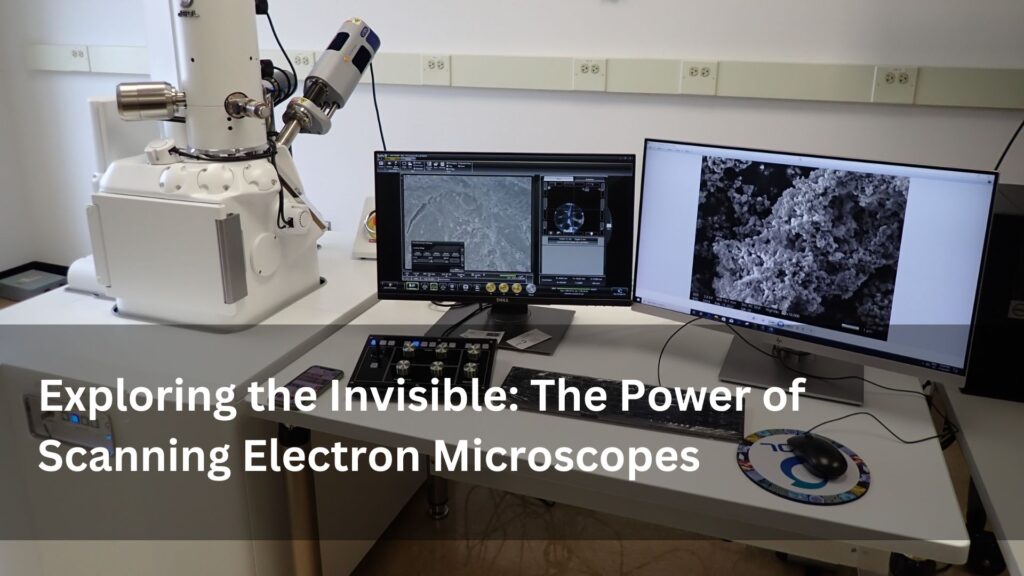In the field of scientific imaging, few tools have revolutionized research as significantly as the scanning electron microscope (SEM). Offering extraordinary depth of field and ultra-high resolution, SEMs provide a detailed look into the microscopic world far beyond the capabilities of traditional light microscopes. Whether used in materials science, biology, forensics, or semiconductor research, the scanning electron microscope is an indispensable device for accurate surface analysis and elemental composition.
This article explores the principles, components, benefits, and cutting-edge applications of scanning electron microscopes, offering a complete guide for researchers, engineers, and curious minds alike.
What Is a Scanning Electron Microscope?
A scanning electron microscope is a type of electron microscope that produces high-resolution images by scanning a specimen with a focused beam of electrons. Unlike optical microscopes, which use visible light, SEMs rely on electrons to achieve far greater magnification and clarity. The electrons interact with atoms in the sample, producing signals that provide detailed information about surface topography and composition.
How Does a Scanning Electron Microscope Work?
The operation of a scanning electron microscope involves several key components:
Electron Gun: Generates a beam of electrons.
Condenser Lenses: Focus the electron beam into a fine probe.
Scanning Coils: Deflect the beam to scan across the specimen.
Detectors: Capture emitted signals, such as secondary or backscattered electrons.
Vacuum Chamber: Maintains an electron-friendly environment.
These components work together to produce real-time, high-definition imagery of microstructures and nanostructures, providing essential insights for analysis and diagnostics.
Types of Scanning Electron Microscopes
Several types of SEMs exist, each tailored to specific applications:
Conventional SEM: Standard imaging for topography and morphology.
Environmental SEM (ESEM): Allows imaging of wet or non-conductive samples.
Field Emission SEM (FE-SEM): Offers higher resolution for nanoscale imaging.
Each type has unique advantages, and choosing the right scanning electron microscope depends on the material type, desired resolution, and sample preparation conditions.
Advantages of Using a Scanning Electron Microscope
Using a scanning electron microscope offers numerous benefits:
High Resolution: Enables viewing features smaller than 1 nanometer.
Great Depth of Field: Produces 3D-like surface images.
Elemental Analysis: With EDS (Energy Dispersive X-ray Spectroscopy), SEMs can identify chemical composition.
Non-Destructive Testing: Minimal to no damage to the specimen.
Versatility: Effective for metals, polymers, biological tissues, ceramics, and semiconductors.
Applications of the Scanning Electron Microscope in Industry
The scanning electron microscope is used across numerous sectors:
Material Science: Analyzing grain structure, phase distribution, and surface defects.
Biology: Studying cellular structures, tissues, and biofilms.
Electronics: Examining integrated circuits and detecting faults.
Forensics: Analyzing trace evidence, gunshot residue, and materials.
Geology: Characterizing minerals and fossil microstructures.
The detailed imaging capabilities of SEMs enable professionals to make precise decisions and maintain high-quality standards.
Limitations of a Scanning Electron Microscope
While powerful, the scanning electron microscope does have some drawbacks:
Cost: Acquisition and maintenance are expensive.
Sample Preparation: Non-conductive materials may require coating.
Size Constraints: Bulky setup and limited to small sample sizes.
Vacuum Requirement: Some samples may be unsuitable for vacuum environments.
Being aware of these limitations helps in selecting the appropriate method for material analysis.
Future Innovations in Scanning Electron Microscope Technology
Emerging technologies are pushing the boundaries of what a scanning electron microscope can achieve:
Cryo-SEM: Preserves and images hydrated biological samples in a frozen state.
Automated SEMs: Integrate AI for sample recognition and faster analysis.
Correlative Microscopy: Combines SEM with light microscopy or atomic force microscopy.
These developments are making SEMs more user-friendly and expanding their role in multidisciplinary research.
How to Choose the Right Scanning Electron Microscope
When selecting a scanning electron microscope, consider:
Resolution Requirements: Based on the scale of the structures to be analyzed.
Sample Type: Biological vs. industrial materials.
Add-ons: Need for EDS, WDS, or cryo-capabilities.
Budget: Evaluate both initial and operational costs.
Working with reputable vendors and assessing lab-specific needs ensures optimal investment.
Conclusion
The scanning electron microscope stands at the forefront of modern analytical tools. With its ability to reveal previously invisible worlds at the micro and nano level, it continues to shape progress in science, medicine, and engineering. Whether for research, quality control, or innovation, the SEM remains a powerful ally for anyone needing detailed and accurate imaging.
As technologies evolve, the scanning electron microscope will become even more accessible and powerful—unlocking new possibilities across every scientific frontier.










